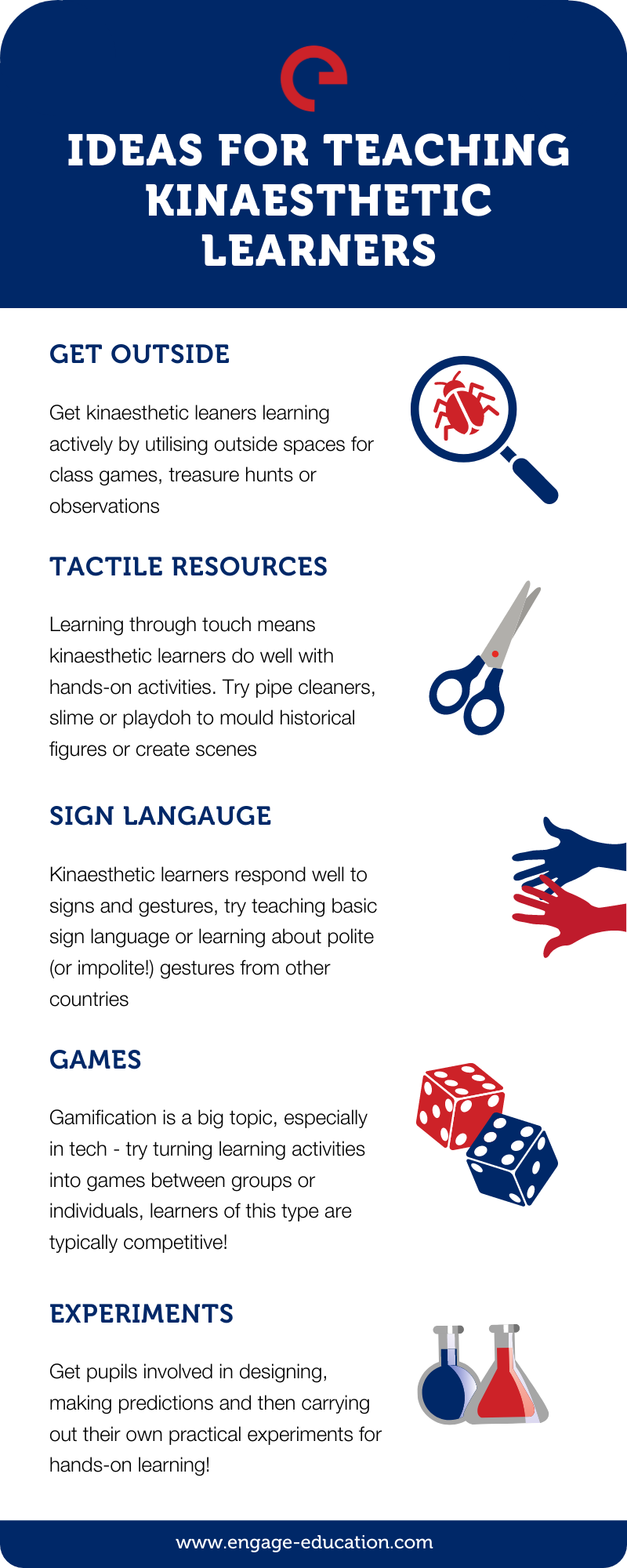
24th March 2023
Learning Styles: Kinaesthetic Learner Characteristics – Engage Education |
What is kinaesthetic learning?
Kinaesthetic Learning is a specific style of learning, we all have preferred learning styles that help us to engage with content and retain information. The three core learning styles are Auditory, Visual and Kinaesthetic Learning. These were identified using the VAK learning model.
Kinaesthia is defined as the ability to understand your body and how your body parts are moving which is why kinaesthetic learning happens when we have a hands-on experience. An example of a kinaesthetic learning experience is when a child learns to use a swing or to ride a bike. They can read instructions or listen to instructions, but deep learning occurs via the process of doing.
Characteristics of Kinaesthetic Learning
Kinaesthetic learners need a multi-sensory learning environment for deep learning as they learn through ‘doing’. A kinaesthetic learner is someone who needs to be actively engaged in their education They are ‘tactile’ learners who use movement, testing, trial and error and a non-traditional learning environment to retain and recall information.
What are some common Kinaesthetic Learner traits?
If you want to explore which type of learner you are, try this quiz or, if you want to find out the learning styles of your pupils, try this one!
- Understand more when learning through hands-on experience
- Become easily bored in a traditional classroom
- Learn through movement
- Enjoy sports and physical activity
- Is an active participant rather than a passive observer when learning
- Enjoys opportunities to go on excursions or be outside the classroom –
- Likes to build things and work with their hands
- Loves testing things and experimenting and creating
- Is restless when they are sedentary
- They are hand talkers and expressive in nature.
- They love to try new things and rely on what they can experience or perform
What are the benefits of kinaesthetic learning?
Kinaesthetic learning aids the development of many skills from critical thinking to practical applications, it’s a great way for children to learn:
- Improve cognitive development – thinking and movement are connected as physical activities increase oxygen levels in your blood which then helps fuel the brain.
- Increased information retention – movement and physical activities can help many kinesthetic learners to retain information better.
- Improved social skills – engaging in kinaesthetic activities often involves interacting with and communicating with other people. This helps promote teamwork and cooperation.
- Creative thinking – approaching learning from a different perspective encourages creativity. Kinaesthetic learning puts individuals in a position to explore their own creative ideas.
- Problem-solving – kinaesthetic learning activities encourage students to be active in the process. Finding new ways of solving problems instead of simply observing demonstrations or listening to lectures.
What are the best ways to teach a Kinaesthetic Learner?
When teaching it is important to understand the most effective ways your students retain information and understand the concepts you teach them.
When you can identify those that need a traditional approach, with handouts, lecture-style lessons and verbal summaries, you can cater to the auditory learners.
Students who need mind-maps, colour-coded notes and visual guides will appreciate information set out this way. They are visual learners.
Make sure you have ‘hands-on’ experiences, lessons that have a practical aspect and include movement for kinaesthetic learners.
Kinaesthetic Learning Examples
- Hands-on simulations: where possible, allow students to delve into hands-on experiments, such as when attempting to demonstrate a scientific concept.
- Clickable animations: where a hands-on simulation is not feasible, the chance for students to have an animation they can interact with is a great way to ensure they remain engaged with the concepts they are learning.
- Role-playing and games – this is another excellent way to convey ideas to kinesthetic learners, as it adds a fun and active element to the lesson, enriching their overall learning experience.

Book a CCS Consultation
Our East Anglia team are on hand to support your school or MAT with bespoke recruitment solutions, arrange a consultation with the team today.
Book a timeRecommended for you
Top 5 questions to ask at the end of a teacher interview
An interview for a teaching role can often be a daunting prospect...
- Become a Teacher
- •
- 3 Min Read
Celebrating St. Patrick’s Day In The Classroom
Dia Duit! The 17th of March is St. Patrick's Day in the...
- Become a Teacher
- •
- 3 Min Read
Ways to support your students during Ramadan
What is Ramadan? Ramadan, the ninth month of the Islamic calendar has...
- Become a Teacher
- •
- 3 Min Read


